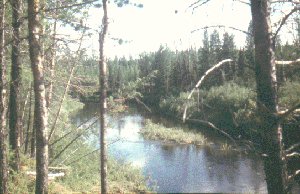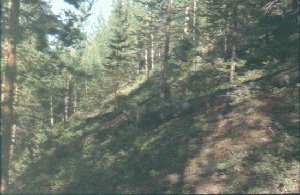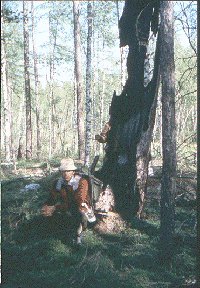 The Journey
The Journey
Through a mystery
http://www.astro.hr/spaceguard_e/html/expedition.html
Korado Korlevic
Still being a child, I’ve come across the Tunguska event through reading popular magazines. Science fiction novels, such as “Conquerer 2 isn’t responding” by Bjazic and Furtinger, which describes the event as a spaceship explosion. This book further ignited the imagination of a child. Of course, at the time I had no idea that I’ll be one of the leaders of “The First International Expedition” in the area.
Years passed by. Sometimes, here and there, I’d find a more or less serous article on the still unexplained event and the often question coming to my mind was :”Is it possible that nothing new can be found which would explain us the cause of that explosion” ?
In 1989. changes are starting to be felt in the Soviet Unon, and a unique opportunity for international research of the Tunguska explosion appears, so professors Gennadij V. Andreev and Nikolai V. Vaslijev, leaders of the research at Tomsk University and the USSR Academy of Sciences and Arts set up an international contents for new projects of research in the area.
The challange was great, an opportunity for the dream to come true - to contribiute to revealing the Tunguska explosion mistery, on scientific basis.
That was the start of painstaking research of literature, talking to friends in the USSR, browsing through the Trieste observatory library, and finally submitting the projects. In the spring of 1990 the expedition preparations started at Tomsk University. My projects were accepted.
The journey:
Traveling through the Soviet Union outside the usual tourist routes and visits to “forbidden” areas of Siberia are a special story which can be summarized to :
Detailed preparations, physical trainings, problems with equipement and tickets, leaving from Ljubljana, arriving to Moscow, changing airports, very intensive traveling to meating point at Krasnojarsk, waiting and then flight to Vanavara.
Vanavara, a muddy shanty town lost in a sea of green forest. Only means of transport in and out of there are plains or, sometimes during the summer months, a ship.
 Slika 1: Huљma, najveæi vodeni tok koji vodi u podruèje uniљtenja eksplozijom.
Slika 1: Huљma, najveæi vodeni tok koji vodi u podruèje uniљtenja eksplozijom.
Seing the Potkamenaja Tunguska river, the white nights and the swamp fog was too much for my first day in the Siberian forest (“tajga”). The next day, 16th June, we left in a helicopter towards the epicenter. We flew across wonderfull landscapes - small hills covered with woods strech out to the horizon in every direction. The sky was patched with a white clouds, which threw their shadows against the backdrop of green underneeth. We passed over over rivers, streams and swamps...
Half an hour later we arrive to our first camp.
 Slika 2: Akademik Nikolaj V. Vasilijev i autor putopisa kraj atiљevih stabala isèupanih eksplozijom, na љest kilometara od epicentra.
Slika 2: Akademik Nikolaj V. Vasilijev i autor putopisa kraj atiљevih stabala isèupanih eksplozijom, na љest kilometara od epicentra.
The camp we arrived in was initially built in 1928 by Leonid Kulik during his second expedition to the area. Cabins are built out of wooden logs and of trees thrown down by the 1908 explosion. The inside of the cabin has changed a little since Kulik’s times. Still the shelves contain bottles with medicines originating from Kulik’s expeditions and in the corner a still operational fireplace, built by the first residents of the cabin, sits. We also find a chess set carved out of birch wood by the second expedition members while waiting for the rescue expedition after being swept in a snowstorm.
 Slika 3: Poruљena stabla su joљ vidljiva na ovom juћnom obronku brda iznad kanjona potoka Èurgim. U tom su kanjonu pronaðeni i prvi moguæi krateri nasali u vrijeme eksplozije.
Slika 3: Poruљena stabla su joљ vidljiva na ovom juћnom obronku brda iznad kanjona potoka Èurgim. U tom su kanjonu pronaðeni i prvi moguæi krateri nasali u vrijeme eksplozije.
The nature is beautifull, tough not vey frendly - we instantly met Siberian mosquitoes. Fallen tries can be seen everywhere we look, although new woods has grown rather well. A great difference shows among areas with greater humidity and dry areas - dry areas conserved the fallen trees very well, leaving the impression of Tunguska event happening rather recently, while in humid areas thick layers of moss and lichenes almost completely cover the trees. The top of Ferington hill gives a beautifull view of the devastated area.
Southern and Northern swamp in which Leonid Kulik during his first expeditions searched for the reminants of the impact body and the hills sorounding them. The area is full of hills and is geologically rather old.
All of the greater hills in the local surroundings are reminents of magmatic tubes of vulcans active some 200 milion years ago. Between the hills, riverbeds with swamps and tajga. Beautifull, rich in fish, the rivers Chamba, Hushma, Kimchu and the Churgim stream curl their way through those valies flowing into 80 kilometers distant Podkamenaja Tunguska. Explosion epicenter is on the edge of Southern swamp and you can still find a couple of trees which were left standing after the explosion and which Kulik, for their appearance, called the “telephone poles”.
 Slika 4: U epicentru.
Slika 4: U epicentru.
It’s a strange feeling to stand in the epicenter of the explosion, trying to imagine that morning on 30th June 1908, the fireball approaching, the flash of the explosion, heat wave, shock wave, electrical discharges and the fires which swept through the area for the days to come.
Research was taking place on sites some 10 kilometers distant from the base camp. We were accessing them through the use of rubber boots, gouing through tajga, swamps and peat bogs. On the field samples were collected and all other usefull data we could aquire, and the data reduction and processing was left for later, because due to short timeframe in which the expedition had to be completed, we had to use every day to the best of our abilities for data collection. Geological, biological and chemical research has been conducted on the site. We had a great problem with the humidity and temperature of Siberian nights, to which the usual sleeping bag made no match. We solved those problems by switching our sleeping place to Kulik’s cabin.
I’ve collected around 10kg of samples, some of which were exceptionally interesting. We’ve found, at the edge of the ellipsis of distribution a layer of ashes from the 1908 fire, burried just 5 cm deep. That finding is expected to simplify planning of future expeditions. In the same dig we’ve found ashes surrounded by rasin which dripped of burning trees.
Magnetic anomalies, due to the natural composition of the rocks, were so large that the Sweedish project of magnetic searches couldn’t be completed. We took a cross section of a tree which survived the catastrophy, and in the rasin of that tree uncontaminated particles from the Tunguska body were found.
 Slika 5: Genadij Andreev i Los Bath vrљe magnetometrijska mjerenja na 10 km jugoistoèno od epicentra.
Slika 5: Genadij Andreev i Los Bath vrљe magnetometrijska mjerenja na 10 km jugoistoèno od epicentra.
We haven’t found any larger reminants of the Tunguska body, which actually wasn’t even expected. Because of the lack of electricity, we couldn’t conduct planned exploration of butterfly variability, but instead a general overview of the site entomological fauna was taken.
While passing through the Churgim stream’s canyon, the geological team of the 1990 expedition didn’t conduct exhaustive research of the two smaller craters found there, so further studies are needed to see if any connection exists between them and the 1908 event.
Trip back : Waiting for the chopper, flight to Vanvara, troubles with local authorities, flight towards the Bajkal lake, flight to Krasnojarsk, Transsiberian railroad to Tomsk, the search for plane tickets, flight to Novosibirsk and then flight to Moscow.
Waiting in Moscow. Taking out the samples I collected withought being noticed by the strict Soviet border controll. What an achievment ! Aeroflot plain to Zagreb, train and than finally home, lighter some 18kg (in weight) but heavier for a dream come true.
 Slika 6: Posljednji pogled na Juћnu moèvaru i mladu љumu sa brda Stojkoviè, s opaljenim trupcem u prvom planu.
Slika 6: Posljednji pogled na Juћnu moèvaru i mladu љumu sa brda Stojkoviè, s opaljenim trupcem u prvom planu.
